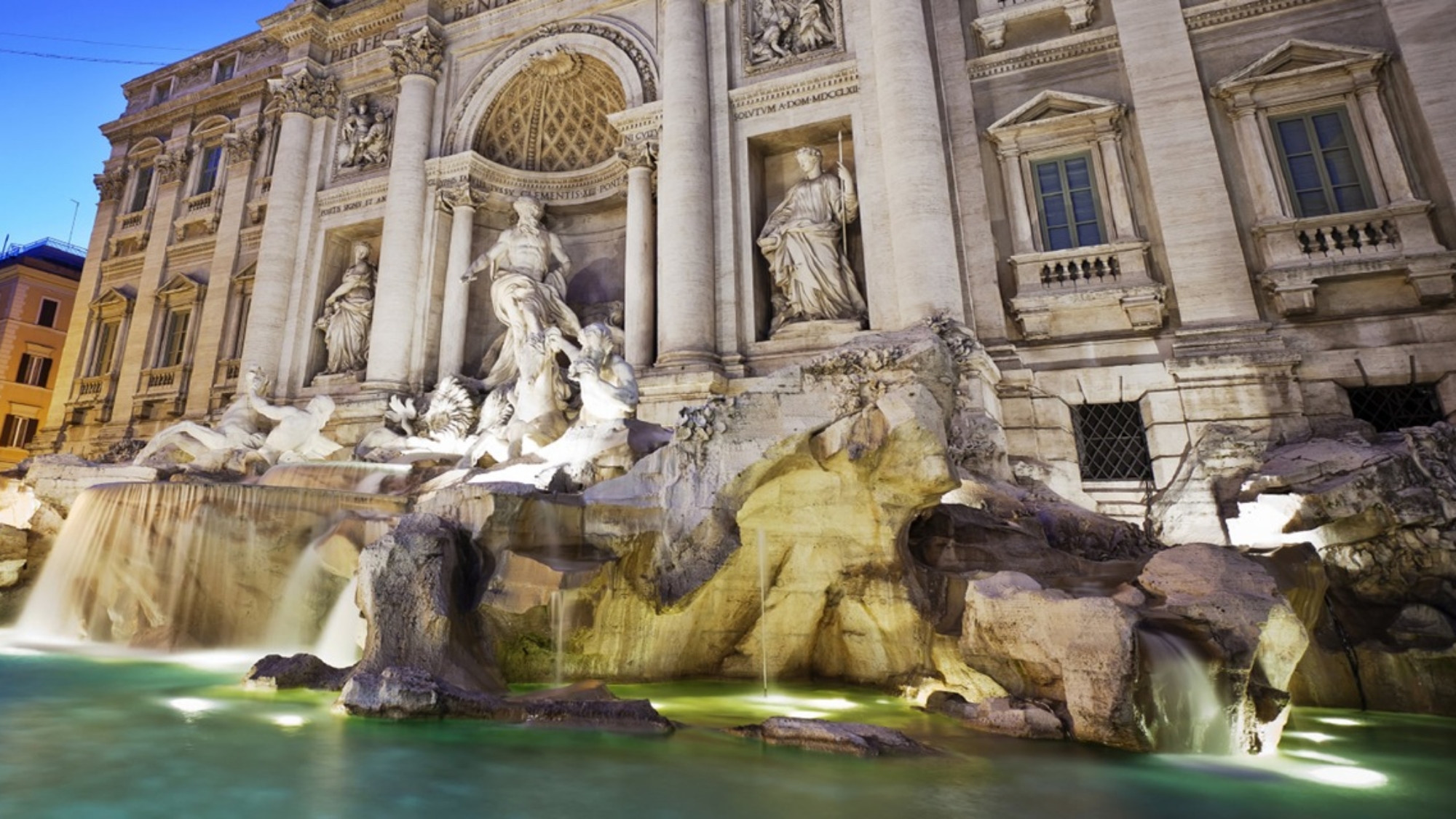Fountains in Italy are among the most beautiful architectural elements you can admire during a journey. We have selected 10 among the most important Fountains in Italy, linking them to interesting legends and traditions.
Fountains in Italy are so many and so different in shape and size that is difficult to count them all and describe them in a few words. The tradition of building fountains can be traced as early as the Ancient Rome Age: Romans’ relationship with water was very strong and this is of course witnessed by the majesty of their baths, aqueducts and fountains.
For most ancient cultures, and Rome was not an exception, water was vital and was therefore considered a gift from the gods. The several water springs located all over the region of Lazio (which contains Rome) were all dedicated by the Romans to the god Fons, while every single source had its own tutelary god or nymph.
The very first fountains in ancient Rome had a merely practical function: to bring water to the population and to livestock, of great importance in a culture who relied so much on breeding as a source of food and wealth. The first fountains were mostly made of rock and in the shape of a simple square, simply featuring a spout to bring water out.
But it wasn’t long before romans started building more decorated fountains. Architectonical elements, statues, apsis and floreal elements were used to adorn fountains all over the city.
Later on, the abundance of water in the whole region, inspired romans to channel it through aqueducts, making it possible to build fountains everywhere in the city, not only near natural springs. This led also to the building of bigger fountains, which sometimes were as big as monuments.
Today all italian cities have their own fountains adorning squares and streets: from the huge and majestic ones, like Trevi Fountain, to the small and ubiquitous small fountains scattered all through the territory, which are a continuous source of fresh drinking water for the lucky tourists!
We have collected for you ten of the most beautiful Fountains in Italy, along with curiosities and traditions linked to them.
1. Trevi Fountain in Rome

One of the most monumental Fountains in Italy, Trevi Fountain is the fruit of long-running, discontinuous working by different architectects, including Bernini. It was actually completed by architects Nicola Salvi and Giuseppe Pannini, who put the finishing touches on the fountain between 1732 and 1766.
With its 85 feet height and 65 feet width, it’s the biggest fountain in the entire city of Rome. In the center of Trevi Fountain a statue of god Oceanus dominates the scene, on top of a shell-shaped chariot, pulled by two horses. To each side of the god the architects put a statue: those of the gods of Health and Abundance.
The fame of Trevi Fountain has two different reason. First of all, Rome’s biggest fountain appeared in more than one movie, the most famous being Fellini’s “La Dolce Vita” and “Roman Holiday”, starring Audrey Hepburn. Not everyone knows about these movies, but we’re sure most tourists know the legend linked to Trevi Fountain. The original legend says that if you throw a coin into the fountain – with your back to it – that will make sure you return to Rome. This is such a popular tradition that Rome’s Council drags each day an average of 3,000 euros coins from the bottom of the fountain! Part of the money is used to fund charity projects, for example it was used to build a supermarket for the poors, an idea of Italian Red Cross
2. Fountain of Neptune in Bologna

Another God of the Waters is the main character of another of the best Fountains in Italy: a bronze sculpture of Neptune, the God of the Sea, takes centre stage on the Fountain of Neptune, in the eponymous Piazza in Bolgona, north of the country.
This monumental bronze and marble fountain is an early work by Giambologna, completed about 1567: Neptune’s figure is depicted extending his reach in a lordly gesture of stilling and controlling the waters, sorrounded by nereids. The statue of the god Neptune was placed at the exact point where the cardo and the decumanus – the proto-typical main streets of any Roman city – intersected.
An interesting legend is worth mentioning: it says that before an important exam, students must walk around twice Neptune’s Fountain counter clock-wise, if he wants to pass the exam, just like architect Giambologna did to celebrate when he finished working on the fountain.
3. Fountain of the Four Rivers in Rome

The fountain, located in Piazza Navona, in Rome, was created by Gian Lorenzo Bernini, one of the most celebrated sculptors in history. The giant statues adorning the fountain symbolize what were considered the world’s four greatest rivers (the Nile, the Ganges, the Danube and the Rio de la Plata) and the four continents that were known at the time. The sculptures rest on a big rock that rises from a circular basin and are surrounded by animals and flora of each continent. The fountain culminates in a tall obelisk that rests on a large plinth.
4. Fountain of the Elephant in Catania

If you decide to visit the wonderful Region of Sicily, pay a visit to Catania to admire its famous “elephant fountain”: the elephant figurine inserted in the fountain, which balances an obelisk on its back, is made from the black lava of Mount Etna and some say it might date back to ancient Roman times. But this fountain, made by architect Vaccarini, is definitely more recent, having been completed only in 1736.
5. Arethuse Fountain in Sicily
Continue your trip of Sicily and reach one more example of Fountains in Italy: on the Ortygia island, near the city of Siracusa, you can admire an enormous fountain, whose legend will remember you how romantic Italy can be! Ancient Greek legend says that Goddess Artemis turned the nymph Arethusa into this fountain, so that she could avoid losing her virginity, which was endangered by the passionate river god Alpheus. In turn, God Alpheus asked to be turned into a river, so that, flowing into the sea-water spring, he could finally unite to her beloved Arethusa.
6. Fountain of the 99 Spouts in L’Aquila

The Fountain of 99 spouts is one of the most icon monument in L’Aquila, in the Abruzzo region, probably erected in 1272. Trapezoidal based, it is made up of two separate basins and intertwined slabs made of white and rose stone, which were take from a nearby cave. The fountain main feature is a series of 99 stone masks called “cannelle”, literally “spouts”. Water comes out from the most of them. According to the legend, the spouts represent the lords of the 99 castles that united to found in L’Aquila in XIII century. In fact, it is said that L’Aquila is made up of 99 squares, 99 churches and 99 fountains.
After undergoing serious damages after the earthquake of 2009, the Fountain of 99 spouts has been recently restored with funds raised by Italian National Trust (FAI).
7. Barcaccia Fountain in Rome

The abundance of water in centre Italy inspired the Romans to channel it through their monumental aqueducts. Aqueducts became important centuries later also for the Catholic Church, which used them to manifest its power on earth: still today you can see the family crests of the main Popes branded onto many Fountains in Italy!
The most famous example of this is the “Barcaccia Fountain” in Piazza di Spagna (right in front of the Spanish Steps, also known as Scalinata di Trinità dei Monti). This Fountain was built between 1627 and 1629 and is the work of Gian Lorenzo Bernini’s father, Pietro. The peculiar name of the fountain, Barcaccia (literally, “ugly boat”) refers to the legend saying that a boat was found in this Piazza, after the great flood of the River Tiber in 1598.
The boat has recently been restored and polished and remains one of tourists’ favourite spots for taking a picture to remember them of their journey in Rome.
8. Bargello Fountain in Gubbio

This characteristic and well-preserved fountain in Gubbio, dating back from the 14th century, takes its name from the palace it stands in front of, tradtionally the residence of the “Bargello”, the magistrate in charge of the city police. This fountain is also called “la fontana dei matti” (“the fountain of the madmen”) and is very famous among Italians. This popularity is due to a funny legend, according to which visitors can gain the license of “matto di Gubbio” (literally, “madman of Gubbio”) if they are baptized with its waters and after running three times round it!
Geologic studies have tried to explain this strange tradition: peculiar rock formations that surround the city of Gubbio show that the territory has been contaminated for a long time by highly toxic iridium!
9. Fountains in the Palace of Caserta

The Palace of Caserta is a former royal residence in the city of Caserta, southern Italy, near Naples. Built for the Bourbon kings of Naples it is one of the largest buildings erected in Europe during the 18th century. In 1997 it was even was designated a UNESCO World Heritage Site. Inside this huge Palace, several fountains can be admired, adorning a monumental park which was modeled after that of Versailles. Their names are:
- The Fountain of Diana and Actaeon
- The Fountain of Venus and Adonis
- The Fountain of the Dolphins
- The Fountain of Aeolus
- The Fountain of Ceres
The Fountains waterway, fed by a Caroline aqueduct, shows Vanvitelli’s ability to create optical illusions: the linear canal shows a discontinuous articulation, alternating big basins, little waterfalls and wide segments of grass land: a solution which, together with the slope on which the fountains are built on, creates an optical artifice that makes the street seems shorter than it actuall is (around 3 km). The most evocative aspects of the waterway are of course the fountains, decorated with a very rich sculptural apparatus.
10. Babuino Fountain

The fountain of the Babuino (meaning Baboon) gives its name to Via del Babuino, which runs parallel to wider Via del Corso, the main shopping street in Rome. A small statue of Silenus (the ancient Greek woodland satyr) is reclined and adorns a fountain just outside the church of St Athanasius, which used to be a fountain horses could drink from. His wicked grin and his grubby brown torso makes this statue look a lot like a Babbon and make it one of the most impressive among the “talking statues” of Rome.
If you want to know what the Talking Statues of Rome represent, read our article on the Talking Statues of Rome!
.




